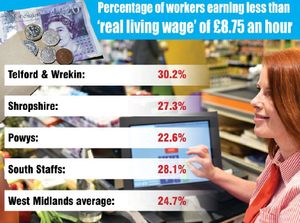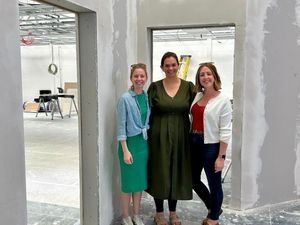Almost third of Shropshire workers earn less than 'living wage'
Almost a third of workers in Shropshire earn less than the 'real living wage' – with Telford & Wrekin having one of the worst rates in the West Midlands.
New figures from the Office for National Statistics identified Telford and surrounding areas as a low pay hotspot, with 30.2 per cent of workers earning less than £8.75 per hour.
The picture was slightly better in the rest of the county, with 27.3 per cent of jobs in the Shropshire Council area being paid below £8.75 an hour. But the area still fared worse than the West Midlands average of 24.7 per cent.
In Powys the figure was 22.6 per cent, while in South Staffordshire it was 28.1 per cent. In Wolverhampton 24.8 per cent of jobs paid below the Real Living Wage, compared to 26.5 per cent in Dudley and 29.1 per cent in Sandwell. In Walsall the figure was 30.2 per cent, the same as in Telford.

The Real Living Wage, which has risen to £9 an hour since the figures were compiled, is higher than the official living wage introduced by the Government in 2016 which employers are obliged to pay all workers aged 25 and over.
It is set by the Living Wage Foundation, which calculates the minimum amount a person needs to meet their everyday living costs.
The foundation argues that businesses paying the living wage benefit from more productive and motivated workers.
Dynamic
Director Katherine Chapman said: "If we want to build a modern, dynamic economy, we need to see more businesses step up and join the over 5,000 Living Wage employers committed to pay a fair day’s pay for a hard day’s work."
The figures show stark variations across the country, with the proportion of workers earning below the living wage ranging from a low of 6.3 per cent in the City of London, to a high of 48.7 per cent in Redbridge, East London.
Regionally, the East Midlands has the highest proportion of low earners at 29.6 per cent, while the south-east had the lowest at 18.8 per cent.
A spokeswoman for the Department of Business, Energy and Industrial Strategy said it was committed to fair pay for workers.
"Last month’s rise in the National Living and Minimum Wage has benefited millions of people, and our minimum wage rates are now among the highest in the world," she continued.
Thousands struggle to live on earnings
There are 68,000 workers across Shropshire and Mid Wales who are not earning enough to meet their basic needs, according to new figures.
Statistics released by the Office for National Statistics showed that Telford & Wrekin was one of the worst low-pay blackspots in the West Midlands, with 27,000 workers – 30.2 per cent of the total workforce – earning less than £8.75 an hour.
The rest of Shropshire also had above-average levels of low pay compared to the West Midlands as a whole, with 32,000 workers earning less than the ‘real living wage’ – 27.3 per cent of the workforce. The West Midlands average is 24.7 per cent.
By contrast, Powys fared better, with just 9,000 workers – 22.6 per cent of the workforce – earning below the £8.75 threshold.
The real living wage, which has risen to £9 an hour since the figures were compiled, is higher than the legally binding official living wage.
The official living wage is set at £8.21 an hour, and is based on recommendations from the Low Pay Unit. It is the legal minimum that companies can pay workers over the age of 25.
The Real Living Wage is set by the Living Wage Foundation which calculates the minimum amount that workers need to earn in order to meet their everyday living costs.
The figures reveals that women and part-time workers were most likely to suffer from low pay.
In Shropshire, 31 per cent of women earned less than £8.75 an hour, compared to 23.5 per cent of men. The gap was even bigger in Telford & Wrekin, with 37.1 per cent of women earning below the threshold, compared to 23 per of men.
The majority of low-paid workers in Telford & Wrekin were in part-time employment, accounting for 56.6 per cent of those earning less than the Real Living Wage. Just a fifth of full-time workers were paid below the threshold.
For the rest of the county, the difference was slightly less pronounced, with 42.5 per cent of part-time workers earning less than £8.75 an hour, and just 18.5 per cent of full-time workers falling below the threshold.
In Powys, 41.6 per cent of low-paid workers were in part-time work, while just 14 per cent of full-time workers were paid less than the living wage.
Unions have seized on the figures, arguing that wealth should be passed to workers through wages. Steve Turner, assistant general secretary of the Unite union, said: “For too many people, the insecurity of not knowing if they will earn enough to pay the bills and put food on the table is a daily fact of life.
Strategy
“It is an obscenity that we have 151 billionaires in this country while 4.1 million children in working households are living in poverty.”
Councillor Lee Carter, Telford & Wrekin Council’s cabinet member for the economy, said the borough has traditionally had a much stronger manufacturing base than many other areas which tended to have a higher proportion of lower paid jobs.
But he said the council’s strategy was to drive up workforce skills to equip people for higher paid employment as well as attracting higher-end businesses to the borough that would provide better-paid jobs.
“Recent success such as winning the MoD fulfilment centre at Donnington, retaining and attracting high-tech employers such as Magna to the borough is evidence that this strategy is paying off,” he said.
Councillor Carter said the council also played an important role in keeping Capgemini in Telford , which was one the borough’s largest employers contributing to Telford’s strong position in information and communications technology.
“Six per cent of borough jobs are in this sector, jobs which are mainly highly skilled and specialist,” he said.
“At the same time we have made £200m investment into our schools to ensure that young people can be as well prepared as possible while our Job Box programme is all about ensuring people have the right skills for employment into the future.”
Challenges of paying staff the Living Wage
Employers across the region have admitted to the challenges of paying staff the Living Wage.
They say there is a fine balance of recruiting and retraining the best staff against profitability.
Sophie Williams, finance director at Telford-based Corbetts the Galvanizers, one of the UK’s longest established hot dip galvanizers, said it has restructured its pay rates over the last 12 months in light of changes to the Living Wage.
“Although general operatives start on the minimum £8.21, we now offer a structured training and development path that if successful will offer rates in excess of the ‘real’ Living Wage,” she said.
“Our business suffers from extreme swings in staff attrition and are looking to stabilise this by offering a career path. We recognise that a stable and competent workforce is the key to growing our market share and, if we achieve this, it will help deliver consistency in service and quality.
“It’s difficult for a business like ours – where there are natural work/project peaks and troughs throughout the year – to pay really high wages all the time. However, we are hoping that by skilling up our workforce and managing the attrition rate down, we can increase profitability and secure higher rates for our workers in the near future.”
Skilled
Steven Owen, managing director of Shropshire-based Pave Aways, said the building firm had made a conscious decision to pay higher than the Living Wage despite the impact on profitability to ensure it could recruit and retrain the best staff.
“Our rates of pay are over the Living Wage and significantly higher than many construction firms in Shropshire but that means we have been able to develop a highly skilled and dedicated workforce which adds huge value to our business.
“If you pay people what they are going to be worth and train them well, it will pay dividends for your business. We’re always looking for the best talent and are prepared to make a short term investment for long term gain to grow our business in a sustainable way,” Mr Owen added.
Neil Anderson, of the Black Country Chamber of Commerce, said: “It’s very disappointing that the minimum wage across the West Midlands falls behind other parts of the country.
“As a chamber we have to help raise awareness of this issue. We know from research carried out in 2018 that even in senior roles the gender pay gap between male and female is higher across our region.”




